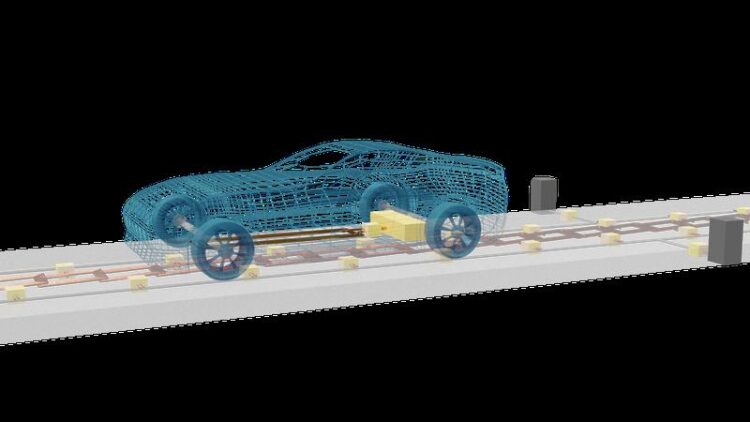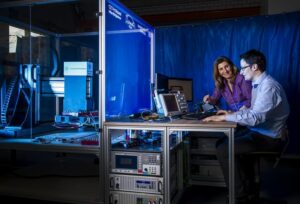Inductive power transmission speeds up e-vehicle charging

Analysis of the energy path offers great potential for further developments in the area of dynamic inductive charging.
Institute for Electrical Energy Conversion, University of Stuttgart
On the street, in the parking lot, at the traffic light …
A great opportunity for development and further expansion in the field of electromobility is inductive charging. Wireless charging makes it possible to automate the charging process so that the battery can be charged automatically at any time, for example in inner-city car parks, in front of traffic lights or on selected sections of road and while driving.
A team of researchers from the Institute for Electrical Energy Conversion (iew) at the University of Stuttgart led by Prof. Dr. Nejila Parspour has been working for years on inductive energy transmission of e-vehicles, among other things. TLB GmbH supports the researchers in patenting and marketing their innovations.

Institute for Electrical Energy Conversion, University of Stuttgart
Inductive charging is a big opportunity for developing and further expanding electromobility. Two big disadvantages of e-automobility could be eliminated with wireless energy transmission: As you can charge more frequently and for a shorter period of time with dynamic charging systems, it would be possible to install smaller batteries, which help reduce lithium consumption. In addition, long charging times at a charging station could be avoided, if it were possible to charge the electric vehicle (EV) inductively in parking lots, at traffic lights or when it is moving.
A research team at the Institute of Electrical Energy Conversion (IEW) of the University of Stuttgart, which is headed by Prof. Dr. Nejila Parspour, has been focusing for years on the inductive energy transfer, among other things, of e-vehicles. Thanks to wireless charging, it is possible to automate the charging process, so that the rechargeable battery can be charged automatically at all times, for example in inner-city parking lots, at traffic lights, on selected road sections and while driving.
The scientists at the IEW are researching the development of wireless electrical road systems with which commercial and passenger EVs can be charged without cables while driving or stationary. This is critical for increasing the range of electric vehicles. The efficiencies achieved with the systems developed at iew are over 95 percent.
Since public charging stations are still rare, inductive charging possibilities would also create more capacity – at relatively comparable costs. The e-vehicle could then be charged on the way to work and in the parking lot. It would no longer be necessary to plug the car in for charging all night, for example.
Prof. Dr. Nejila Parspour sees the greatest potential for further developments in analyzing the energy path. Contactless charging technology works using charging coils. For dynamic charging, i.e. while driving, induction coils will be put into the road surface. As soon as the vehicle is on top of them, the charging coils in the road are activated, and transfer electrical energy to the vehicle via a magnetic field.
The scientific team around Prof. Parspour has already filed patent applications for different inventions in order to further advance the idea of inductive static and inductive dynamic charging. One of the most important inventions relates to positioning tolerance that allows for inductive charging regardless of the vehicle height and width.
A number of other inventions have further increased the efficiency of the systems developed at the IEW. Other already patented inventions relate to foreign body detection. This way, the charging system can detect when a foreign body that could heat up is on the induction coil. In addition, the scientists at the Institute for Electrical Energy Conversion are also conducting research in several projects funded by the Vector-Stiftung, including in the area of 48-volt-based charging while driving.
The IEW team is also working on the economic efficiency and size of components for charging systems. In addition to the infrastructure, i.e. the coils in the energy path, the receiver coils must also be built as light as possible with the greatest possible efficiency. The goal is to achieve a stable system with just a few components. This reduces costs, increases efficiency and saves installation space and weight, which is also an important factor for an electric vehicle.
EP applications are pending. Technologie-Lizenz-Büro (TLB) GmbH helps the University of Stuttgart patent and market its innovations. TLB has been commissioned with the business implementation of this pioneering technology and offers companies possibilities to cooperate and license the patents.
For more detailed information, please contact Innovation Manager Emmerich Somlo (somlo@tlb.de)
Wissenschaftliche Ansprechpartner:
Nejila Parspour, nejila.parspour@iew.uni-stuttgart.de
Lukas Elbracht, lukas.elbracht@iew.uni-stuttgart.de
Marco Zimmer (Administrativ), Jannis Noeren, Tobias Götz
Weitere Informationen:
https://www.tlb.de/presse-news/presse-news-artikel/auf-der-strasse-auf-dem-parkp…
https://www.iew.uni-stuttgart.de/
Media Contact
All latest news from the category: Power and Electrical Engineering
This topic covers issues related to energy generation, conversion, transportation and consumption and how the industry is addressing the challenge of energy efficiency in general.
innovations-report provides in-depth and informative reports and articles on subjects ranging from wind energy, fuel cell technology, solar energy, geothermal energy, petroleum, gas, nuclear engineering, alternative energy and energy efficiency to fusion, hydrogen and superconductor technologies.
Newest articles

Innovative 3D printed scaffolds offer new hope for bone healing
Researchers at the Institute for Bioengineering of Catalonia have developed novel 3D printed PLA-CaP scaffolds that promote blood vessel formation, ensuring better healing and regeneration of bone tissue. Bone is…

The surprising role of gut infection in Alzheimer’s disease
ASU- and Banner Alzheimer’s Institute-led study implicates link between a common virus and the disease, which travels from the gut to the brain and may be a target for antiviral…

Molecular gardening: New enzymes discovered for protein modification pruning
How deubiquitinases USP53 and USP54 cleave long polyubiquitin chains and how the former is linked to liver disease in children. Deubiquitinases (DUBs) are enzymes used by cells to trim protein…



